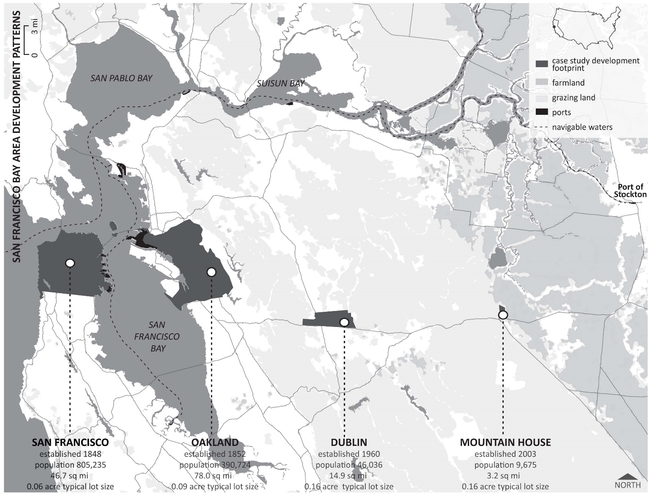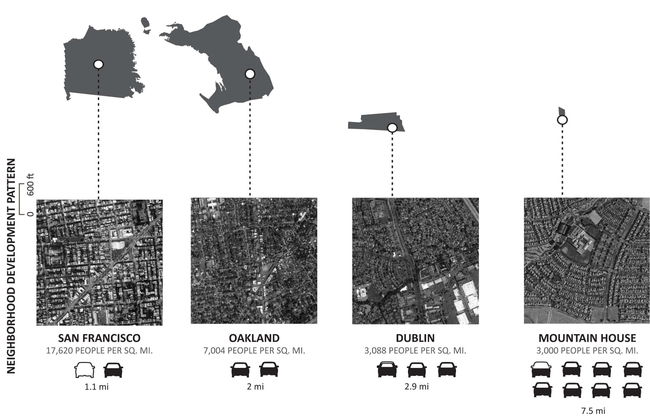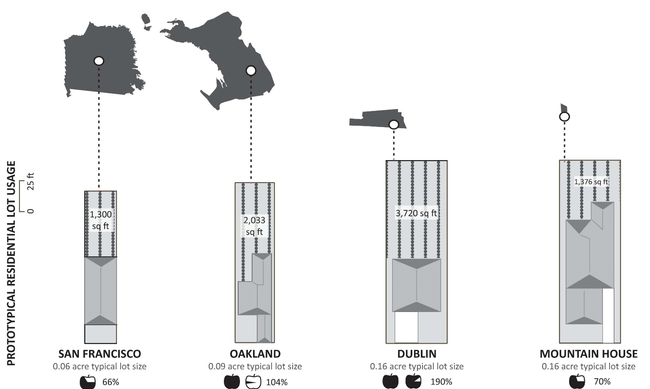
Posts Tagged: food system
Evaluating Regional Food Resilience in the San Francisco Bay Area
While the provision of clean water, removal of wastes, and infrastructure for other basic human necessities are considered in the planning of modern development in the United States, the provision of food is rarely a consideration. More often, transportation infrastructure, including roads, ports, and rails, is considered synonymous with food infrastructure, and little attention is paid to distances from the development to food retail, distribution hubs, ports, or food sources. In modern development it is assumed where there is a road, there will be food. This was not the case in pre-Industrial development; limited means of high-speed transportation, and the absence of technologies such as refrigeration, required carefully planned development to maximize efficiencies of transportation and proximities of food sources.As communities strive for increasingly sustainable means of development, an important consideration is planning for food resilience, of the ability to secure food within one's community in light of outside stressors such as natural disasters or limited fuel resources. Food resiliency requires balancing several considerations related to the locality of food, and contains a greater degree of complexity than the popularized 100 mile ‘local food' radius. While greater densities of development receiving efficient modes of food distribution offer one facet of food resilience, lower densities that offer opportunities for in-situ production provide yet another.
This research investigates relative food system resiliency by evaluating opportunities for adapting food systems within existing community patterns. The San Francisco Bay Area provides a relevant case study of both pre- and post-industrial development at a range of densities and networked with multiple transportation infrastructures. The evaluation of communities within this region reveals important considerations for environmental designers aiming to increase food system resilience in new and existing communities. This includes examining multiple scales of adaptation to production and distribution networks, and challenges the popularized 100 mile ‘local food' radius for achieving regional food resilience.
The study examines a convenience sample of four communities on a rough east-west transect within the San Francisco Bay Area and along Interstate 580: San Francisco, Oakland, Dublin and Mountain House. See Figure 1. The communities represent a range of densities, area coverage, and populations which correspond roughly to their location along the transect, with the larger and denser communities (San Francisco and Oakland) at the western end, and the smaller and less-dense communities at the eastern end of the transect. The transect is important in both geographic and historical terms, as the western end also corresponds to the oldest community with development occurring in an east-ward expansion.
At the scale of the neighborhood, the study identified travel distance to a full-service retail grocery store as the most significant criterion for assessing community food resilience. Using aerial photography and GIS data, a maximum one-way travel distance within each community to a full-service retail grocery store was established. For this study, a full-service retail grocery store was defined as a supermarket carrying fresh produce, such as Safeway, Andronico's or Lucky's. Convenience stores which sell primarily soft drinks, alcoholic beverages and snacks, were not included, as they do not typically provide access to fruits and vegetables (or other whole foods). The study calculated the average distance to a full-service retail grocery store within the community.
The study also defined the ‘productive potential' of each community, a measure of a typical back yard's ability to meet the fruit and vegetable diet for a family of four, based on average home lot size and coverage, USDA consumption figures and typical home-garden yields. A combination of aerial photographs, zoning maps and real-estate data for each community was analyzed to determine a typical lot configuration for each community, illustrating the average lot size, average home size and coverage. Although individuals may choose to use open space areas on their lots in a variety of ways, including ornamental landscaping, xeriscaping, recreational features such as basketball courts, lawn and hardscaping, in addition to food gardening, the productive potential of any lot is pre-determined by open space provided. Raised bed gardening, a typical home-garden approach to growing food, yields an average 1.24 pounds per square foot. In the U.S. an average of 1.5 pounds of fruits and vegetables is consumed per person per day. The productive potential of each community was derived from applying the raised bed average yield to 90% of the typical lot open space in each community, and then calculating what percentage of the full-year fruit and vegetable diet for a family of four would be met by that yield.
Flexibility is key to resilience. While San Francisco might not be able to produce all its fruit and vegetable needs via urban agriculture, access to multiple neighborhood grocery stores and to efficient modes of food distribution offer alternative means of adopting alternative food systems. Oakland, shares many of the same advantages as San Francisco, but with greater lots sizes (and generally a better microclimate), opportunities for urban agriculture are far greater. Dublin, while not sharing the same access to efficient modes of food distribution as San Francisco and Oakland, offers the greatest opportunities for residential urban agriculture with a productive potential of 190%. With minimal opportunities for home production, great distances between home and local grocery retail, and removed location from efficient distribution centers, the community of Mountain House appears to be the least capable of adaptations to the existing food system.
The results of this research exemplify the need for environmental designers to balance considerations of density and geographic location in new development. While density provides opportunities for limiting personal automobile commute times, it can also interfere with opportunities to promote UA as an alternative food source. Recognizing the geographic location of new development, the impacts to food distribution networks, and the proximity of local food retail outlets should also be an important consideration for environmental designers. In essence, the infrastructure of a community's food system (including global, regional, and local sources and distribution networks) should be an equal consideration to new development in the San Francisco Bay Area, and beyond, if community's are to be designed as resilient food systems.
UC ANR hosts workshops for California's urban farmers
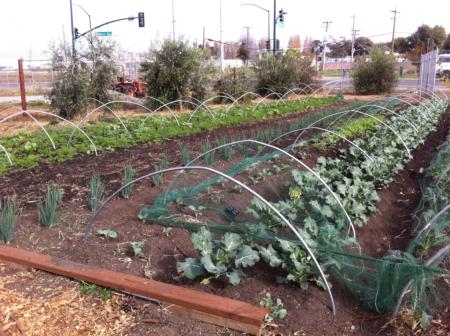
Building on the needs assessment, a team of UC ANR researchers created a resource website for California urban farmers. This year, team members and local partners are conducting a series of trainings for urban farmers around the state, designed to help city growers build their knowledge in key areas. The series just wrapped up in the Bay Area, and will roll out in Los Angeles starting on July 21. The Los Angeles series dates and topics are:
- July 21. Legal Basics of Urban Farming. Are you an urban farmer navigating the rules and regulations related to growing and selling food? A school or non-profit organization involved in farming? This workshop will help position you for success.
- July 28. Production Issues and Urban Farms. Are you an urban farmer learning the ins and outs of growing and harvesting crops? This workshop is designed to guide urban farmers through common production challenges related to soil, water use, and pest management.
- August 4. Marketing and Business Management for Urban Farmers. From business planning to labor laws, learn the basics to help you succeed.
- August 11. Food Safety Basics for Urban Farmers. Learn how to ensure a safe harvest, from the field to the fork.
Local partners are key to planning and hosting these events, including the Los Angeles Food Policy Council, the Collaborative for Urban Agroecology Los Angeles, Cal Poly Pomona College of Agriculture, Community Services Unlimited, GrowGood, the Growing Experience, and others.
The series will also be held in Sacramento and San Diego in early 2018. For updates and announcements, follow UC ANR's Urban Agriculture blog, Facebook, and Twitter. And be sure to bookmark our UC Urban Agriculture website which offers resources on production, policies, and more.
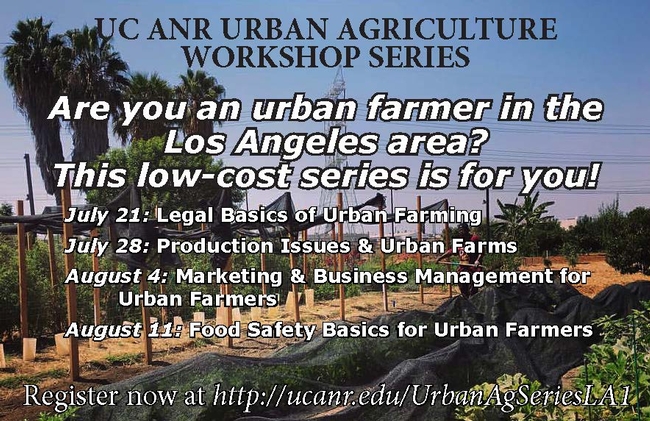
Urban Ag Workshop Series-SoCal 5-23-17A (3)
San Luis Obispo County local food roots are strong, can support growth

A new report assessing San Luis Obispo County's food system links the vitality of the county's agriculture with the health of its residents and its food businesses.
Conducted by the UC Sustainable Agriculture Research and Education Program (UC SAREP) and Central Coast Grown (CCG), the San Luis Obispo County Food System Assessment examines the relationships between agriculture, regional environmental quality, human health and local livelihoods.
“We found that the county food system in San Luis Obispo is thriving with increased agricultural sales and school districts beginning to participate in garden-based education,” says Jenna Smith, executive director of Central Coast Grown. “But there are many opportunities for improvement. With excitement building around local food and improved nutrition, it's vital for a county to see an honest accounting of where it stands in those arenas.”
In 2007, farmers in San Luis Obispo County sold agricultural products valued at $4.3 million directly to consumers, an increase from previous years. The report suggests that continued promotion of local and direct marketing of food can assist all producers, including new farmers, in entering the marketplace and bolstering the local food system overall.
Those markets will be especially important as the number of farmers in the county grows. In 2007, there were 850 more agricultural producers than 10 years prior. But the majority of farms in 2007 reported gross sales of under $250,000 per year, with nearly half of all farms in the county reporting less than $5,000 in annual sales.
“Unfortunately, we have little information available to define who these small-scale farmers are, what they are growing, how they impact local employment, and how they might interact with the local food system,” said Mary Bianchi, director of UC Cooperative Extension in San Luis Obispo County, who advised on the report. “We need a better understanding of what these farmers produce, and how they can better participate in the local food economy.”
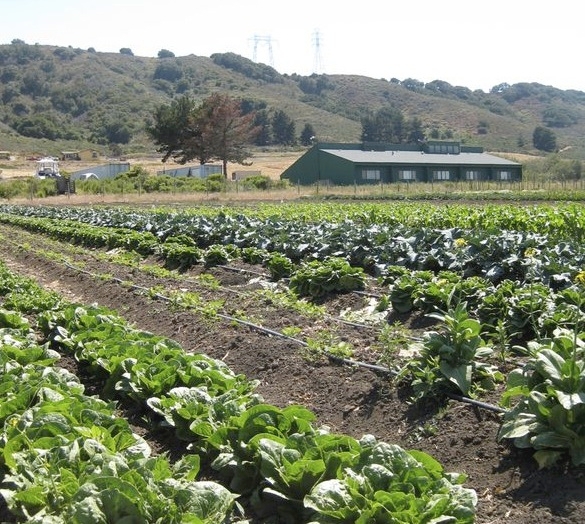
In a parallel survey conducted by Central Coast Grown, they asked farmers and restaurant owners about the challenges to selling and buying locally.
“Our survey reinforced the findings of the SLO Food System Assessment,” says CCG director Smith. “Both farmers and restaurant owners reported a need and value for localized distribution channels.”
The report also addresses access to healthy food as a component of the county's food system. Participation in food assistance programs like CalFresh and food distributed by food banks in San Luis Obispo County have both increased over the last decade, though overall food insecurity in the county has improved marginally.
While increases in food distribution may mean those outlets are accessing more people, it also means more people are in need of the assistance.
Beyond continued support from government food programs, the report recommends ways that increasing food access for the public and improving markets for local producers can reinforce one another. Food-focused community development strategies such as mobile markets, community farms, and farm-to-school bring agriculture into neighborhoods and schools and help close the gap between producers and consumers.

San Luis Obispo County also faces water quality and water quantity challenges that are echoed throughout the state. Nitrate contamination from both urban and agricultural sources affects local lakes, rivers and streams. Groundwater and coastal stream resources both present significant challenges for agriculture and rural communities dependent on them for drinking water.
“Accounting for those concerns within the context of the entire food system may bring a broader scope to the discussion along with the potential to leverage the efforts of the many groups already working on water resources issues,” Bianchi said.
The Food System Assessment was conducted in partnership with the San Luis Obispo County Food System Coalition. Coalition meetings are held quarterly to discuss local food system issues and are open to the community. The report was funded by the California Department of Food and Agriculture which also supports Central Coast Grown's upcoming release of a Public Land Survey that identifies underutilized agriculturally viable land county-wide.
The report is available on the UC SAREP and Central Coast Grown websites.
The power of the foodshed

Some are surprised to learn that as recently as 1950, Los Angeles County was the No. 1 agricultural county in the United States, its farms producing an abundance of fruit, vegetables, eggs, milk, honey and much more. Today, Los Angeles residents tend to think of our county of 10 million residents in strictly urban terms, but the most current available statistics from the USDA Census of Agriculture (2007) showed 1,734 farms in L.A. County. Though ornamental plants are now our biggest crop, more than $31 million in vegetable crops came from Los Angeles County farms in 2011, according to the county’s most recent Crop and Livestock Report. The bulk of the vegetables we produce are root crops, which include onions, carrots and potatoes. Most commercial farming takes place in the high desert around Lancaster and Palmdale, and is seldom seen by most of the county’s population. A sprinkling of small urban farms is also cropping up around the county, as documented by UCLA urban planning students in their recent Cultivate Los Angeles study.
But the amount of food produced in Los Angeles County is just a tiny portion of what’s grown in our regional foodshed, defined as a 10-county region within a 200-mile radius of Los Angeles’ urban core. Our foodshed has some of the most productive farmland in the state, encompassing some 23,000 farms. Strawberries and lemons from Ventura County, lettuce and broccoli from Imperial, and milk and almonds from Kern are some of the highest-value farm products in California.
Yet much of what is produced is shipped to far away markets, and does not reach the plates of area residents. Lack of affordable fresh produce is a fact of life in many Los Angeles County neighborhoods, despite their proximity to agricultural bounty.
Looking at the overall foodshed helped the Council to conceptualize a key initiative, the Good Food Purchasing Program, which encourages institutions to buy from small- and medium-sized regional farms, along with meeting other purchasing goals that make healthy food accessible. The City of Los Angeles and LAUSD (Los Angeles Unified School District) were the first two entities to sign on. The impact of LAUSD’s efforts in purchasing regional food were recently profiled in a Los Angeles Times article that highlighted how new local jobs have been created thanks to LAUSD’s buying power. This is one example of how thinking about food regionally, and working collaboratively across sectors, can help create a stronger food system. As the director of LAUSD’s Food Services said, "It's fresher food from farmers we know," when regional food is on the menu. And, it’s good for the local economy, too.
Sustainability - what does it really mean?

April's Global Food Systems Forum invigorated the conversation. The event convened some of agriculture's leading experts to address the plethora of challenges that face our global food systems. The conversation brought forward several hot topics: GMOs, large scale vs. small scale production, nutrition and more.
But even with the riveting debate, the question remains: What is sustainability? Is it focusing more on natural ecosystems? Is it being completely self-reliant, or turning only to organics? Is it focusing on a larger multi-national scale?
UC ANR has started holding a series of sustainability webinars to continue the conversation and tackle some of these questions. The first webinar took place on Feb. 15, 2013 with Tom Tomich, director of the UC Agricultural Sustainability Institute. The webinar tackled the issue of sustainability: What is it? Is there a sustainability science? What is at stake? The video can be seen on the ASI website.
The second webinar, on May 31, 2013 with Neil McRoberts, professor in the Department of Plant Pathology at UC Davis, focused on linking sustainability theory with practice. McRoberts addressed sustainability theory using formal models to plan and track extension outreach efforts, and linking interdisciplinary scientists. Though the webinar is not yet available online, it will be soon on the ASI website.
The next webinar is Thursday, June 13, from 10:00 a.m. to 12:00 p.m. Featuring Ermias Kebreab, professor in the Department of Animal Science at UC Davis, the webinar centers on environmental sustainability of animal agriculture. Topics will include: sustainability as a "wicked" problem, water quality and livestock production, and the mitigation of air emissions from livestock operations. The webinar is free and open to the public. More information is available on the Agricultural Sustainability Institute website.
Sustainability is a complex issue. These questions about the definition and concept are not going to be answered overnight. But as long as these types of conversations and learning opportunities continue to take place, I'm confident we'll continue adapting and meeting the complex challenges with which we are faced.

